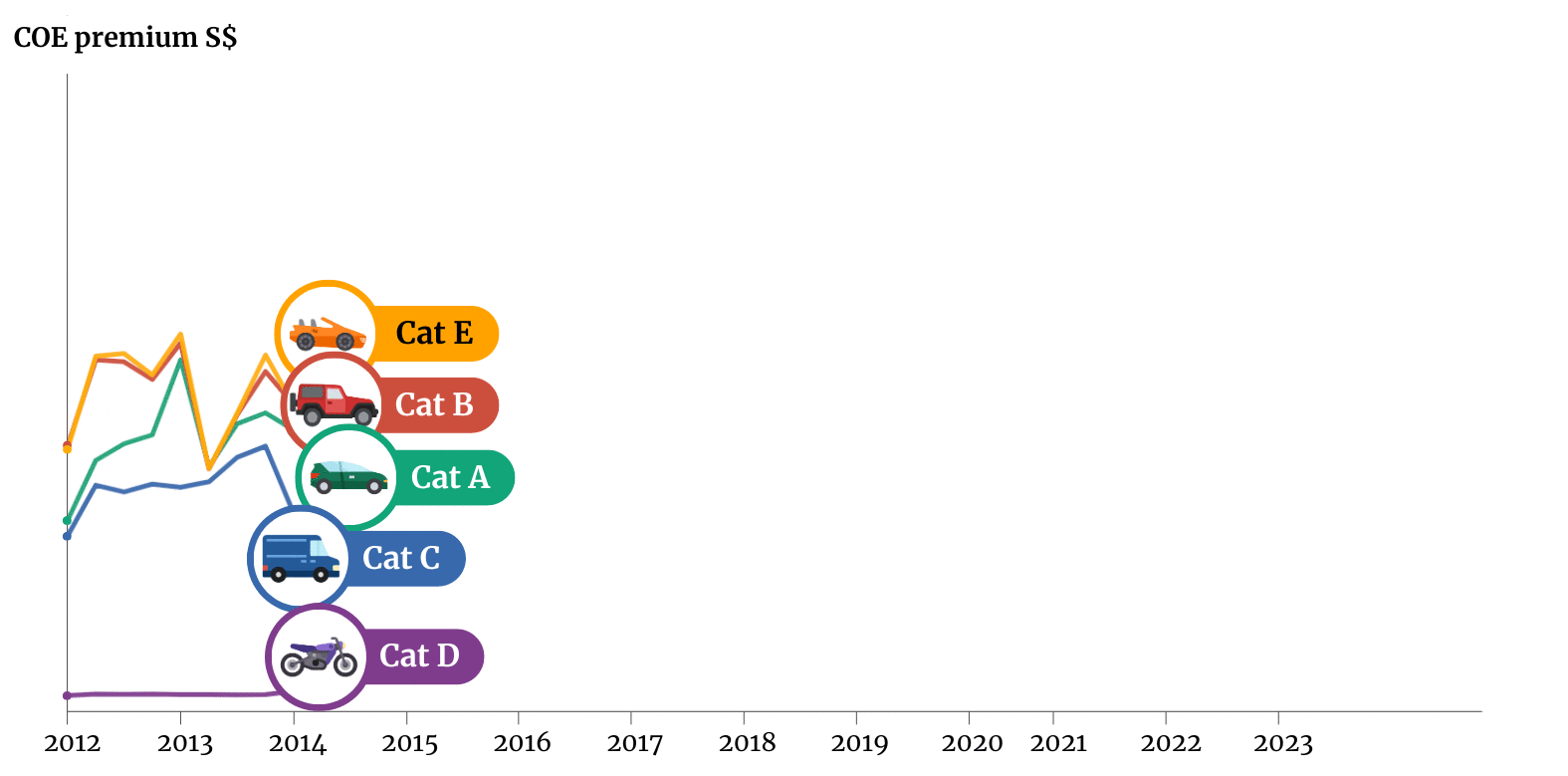A deep dive into COE prices in Singapore: Does the system need an update?
Should certificates of entitlement (COE) for cars be longer than 10 years? Why can’t we have additional buyers’ stamp duty for cars or create car categories based on needs? We take suggestions from the public on refining the COE system to the experts.

COE premium prices over the years. (Animated graphics: CNA/Clara Ho)
Record-high Certificates of Entitlement (COE) premiums have hit the headlines in recent times, and while efforts have been made to increase the supply and bring down prices, the question remains: What more can be done to the existing system to make the prices of premiums less volatile?
The first bidding exercise in October 2023 saw premiums for the Open Category - which can be used for any vehicle type but end up being used mainly for large cars - crossing S$150,000 (US$112,000) for the first time. Category B premiums breached this mark two weeks later.
For perspective, a typical family car such as the base model 1.6-litre Toyota Corolla Altis was marketed at about S$173,000 during that time, taking into account COE registration. Its cost price is closer to S$20,000.
It bears noting that COEs are integral to the Vehicle Quota System, which is a landmark scheme implemented on May 1, 1990, to regulate the growth of the vehicle population in Singapore. Central to the VQS’ outcome is capping the growth rate to 3 per cent per annum, compared with an average of 6.8 per cent per annum in the three years prior.
Since February 2018, a zero-growth rate policy for cars and motorcycles has been in place and will continue until Jan 31, 2025.
In land-scarce Singapore, owning a car naturally comes at a cost. Calls to overhaul the system need to bear in mind the wider policy considerations at play.
To address skyrocketing prices, authorities are increasing the supply of certificates.
In May, the Land Transport Authority (LTA) said it would release more Category A and B certificates by bringing forward guaranteed deregistrations of five-year non-extendable COEs. It later announced a 35 per cent increase in the COE quota for the November 2023 to January 2024 quarter.
What resulted was COE premiums falling across the board in the first bidding round of November, with Category B prices dropping 26.7 per cent to S$110,001. Prices for larger cars rebounded in the next bidding round, but smaller cars saw a further drop to S$85,001.
These were part of the government’s “cut-and-fill” move to tackle the current supply troughs, said Acting Transport Minister Chee Hong Tat in parliament, in response to questions on the system by various Members of Parliament.
But will increasing demand reduce price volatility for long?
The Transport Ministry has said COE prices are expected to trend upwards in the long run, because of the government’s zero-growth policy for the car population and rising household income.
“As household incomes continue to rise in the coming years, coupled with our policy of zero-growth in the car population, we must expect the long-term trajectory for COE prices to be upwards,” said Transport Minister S Iswaran in May 2023.
Does the COE system need an update? CNA posed five common suggestions from the public to transport analysts to see if they are viable.
Q: Why can’t we have different COE categories for private-hire vehicles (PHVs)?
The private car population, including off-peak cars, shrunk from 580,406 in 2012 to 542,145 in 2022. Private-hire cars, meanwhile, have grown from 14,862 to 72,632 over the same period, giving the appearance it is a key driver of demand, and thus price, in recent times.
It’s little wonder then people are calling for a separate category for private-hire vehicles (PHVs) and taxis. But experts say the issue with this suggestion is that publicly available data do not show how PHVs are used.
We do not know whether these cars are being used for private hire, car sharing, or private purposes, transport economist Walter Theseira told CNA. This lack of information makes it difficult to determine whether COE demand can be linked to private-hire companies and their fleets, added the associate professor at the Singapore University of Social Sciences (SUSS).
Data from the Transport Ministry shows the total private-hire car population stands around 78,000, with two-thirds being chauffeured PHCs such as those from ride-hailing companies. The remaining self-drive PHCS include car-sharing vehicles. Both are available for rentals, but only chauffeured PHCs may be used to provide ride-hail services.
Yet, the data does not capture how the vehicles are used in order for demand to be assessed.
Additionally, Singapore Institute of Technology’s (SIT) Zhou Yi said private-hire companies are not always the owners of the PHVs, making it difficult to prevent abuse should a new COE category be created. “Remember, the ‘Uber’ model is a large point-to-point transport without owning any car,” Assoc Professor Zhou said.
He added: “Everyone can go for the PHV category unless the government sets similar KPIs [as it does] for taxi owners.”
Addressing this suggestion in parliament, Mr Chee said there are “trade-offs” to having a separate COE category for car-leasing companies including a risk of further spikes in the prices due to fewer certificates in the market. He added the government would study the possibility of “further options beyond COE bidding” to address these concerns with car-leasing companies.
Q: Why can’t we make COEs last longer than 10 years?
Another suggestion made is to lengthen the 10-year duration of a COE, possibly to 15 or 20 years, based on the reasoning that cars today are made to be more efficient and last longer.
However, Assoc Prof Zhou said this won’t solve the problem in the long term. Instead, it could increase COE prices given the lack of supply due to fewer deregistrations, he suggested.
For Assoc Prof Theseira, the issue of having more efficient and longer-lasting vehicles is not a question that the existing COE system is meant to answer. The Vehicle Quota System, of which COEs are an integral part, is “perfectly successful in managing the vehicle population”.
As shown in the table below, the population of Category A and B vehicles have been kept below 350,000 in each category for the past decade.
However, the issue of “success” is not in the number of vehicles, he said.
“It's the outcomes of the system which are not desirable, such as extreme volatility in COE prices when the underlying economic use of vehicles probably hasn't changed, and extreme volatility in fleet turnover. Both are caused by the COE supply cycle,” he explained.
The economist added it also doesn’t address the question of what the vehicle population target and mix should be. He had previously raised similar concerns and said that, in order to solve these, policymakers need to make judgments about how many vehicles should exist and why.
Q: Why can’t we impose ABSD-type levies for those with more than one car?
To cool the property market when it gets red-hot, authorities tinker with the Additional Buyer’s Stamp Duty (ABSD) where people who own multiple houses pay more in duties.
The idea of imposing a similar levy for car ownership sounds interesting but it is not easy to implement, said Assoc Prof Zhou. For one, he said it is easy to get around as car buyers can register their vehicles under different names.
The number of people owning multiple cars may also not be worth introducing such a scheme, he added. The Transport Ministry had previously said that as of Oct 31, 2022, about 471,000 households own cars; of these, about 12 per cent own two cars and less than 3 per cent own three or more cars.
“Unless there is a significant trend toward percentage of multiple car ownership, it may not be worth introducing ABSD as the nature of owning cars is different from houses,” the SIT professor said.
Q: Why can’t we put a cap on COE premiums?
Experts say this suggestion might lead to other unwanted outcomes.
Assoc Prof Zhou said if the price limit is lower than what consumers are willing to pay, and if the supply of COEs continues to be limited due to the government’s zero-growth policy, then it could lead to authorities having to conduct lucky draws to allocate the available certificates.
“It may even drive more [car] dealers to join in the draws and buyers may have to wait longer,” he said.
This was reiterated by Mr Chee in parliament, saying that such demand-measures “would have little effect on COE prices”.
Q: Why can’t we have car categories based on needs? For example, for families with young children and people caring for the elderly.
For Assoc Prof Theseira, there are two considerations for this: Is there broad societal consensus on whether special considerations should be given to such needs, to whom and to what extent? And is it practical to implement these changes?
“As cars are not necessities the way that housing, healthcare or education are - areas where the government does in fact provide extensive support based on social needs - it is unclear the public would support such measures,” he said.
The benefits would likely go to a certain segment of the middle class, with lower-income Singaporeans unlikely to find cars cost-effective even after the policy change, while high-income Singaporeans won’t benefit by design, the SUSS professor said.
As for whether it’s practical to implement, he thinks it’s only possible with “extensive changes to regulations and enforcement” to disallow any form of “policy leakage” from, say, fake buyers obtaining vehicles cheaply or using the vehicle outside its stated purposes.
So how would experts refine the COE system?
SUSS’ Theseira told CNA that the broader change needed is to revise the COE vehicle mix, look at the supply and growth rates and shift vehicle control more towards paying for usage rather than ownership - including distance-based charges.
“However, those changes would require much more study to be achieved,” he added.
The LTA in October announced a timeline to install the next generation of electronic road pricing units - ERP 2.0 - which could facilitate distance-based charging, but it says it has “no immediate plans” to introduce distance-based road use charges.
Assoc Prof Zhou said any modification or change to the existing COE system will need to consider actual practices by car dealers, taxi operators as well as individuals. This should also be done within the context of the wider zero-growth in car population policy to drive Singapore’s car-lite society ambitions.
Additionally, Assoc Prof Theseira said it will be “challenging” to take away COEs from high-supply years and move these to low-supply years without causing unhappiness.
“But I think from the economic perspective, it is clear that it is not sensible for the COE supply and prices to vary by such a large factor across years when there is little that changes about vehicle demand and use in those different years,” he said.


